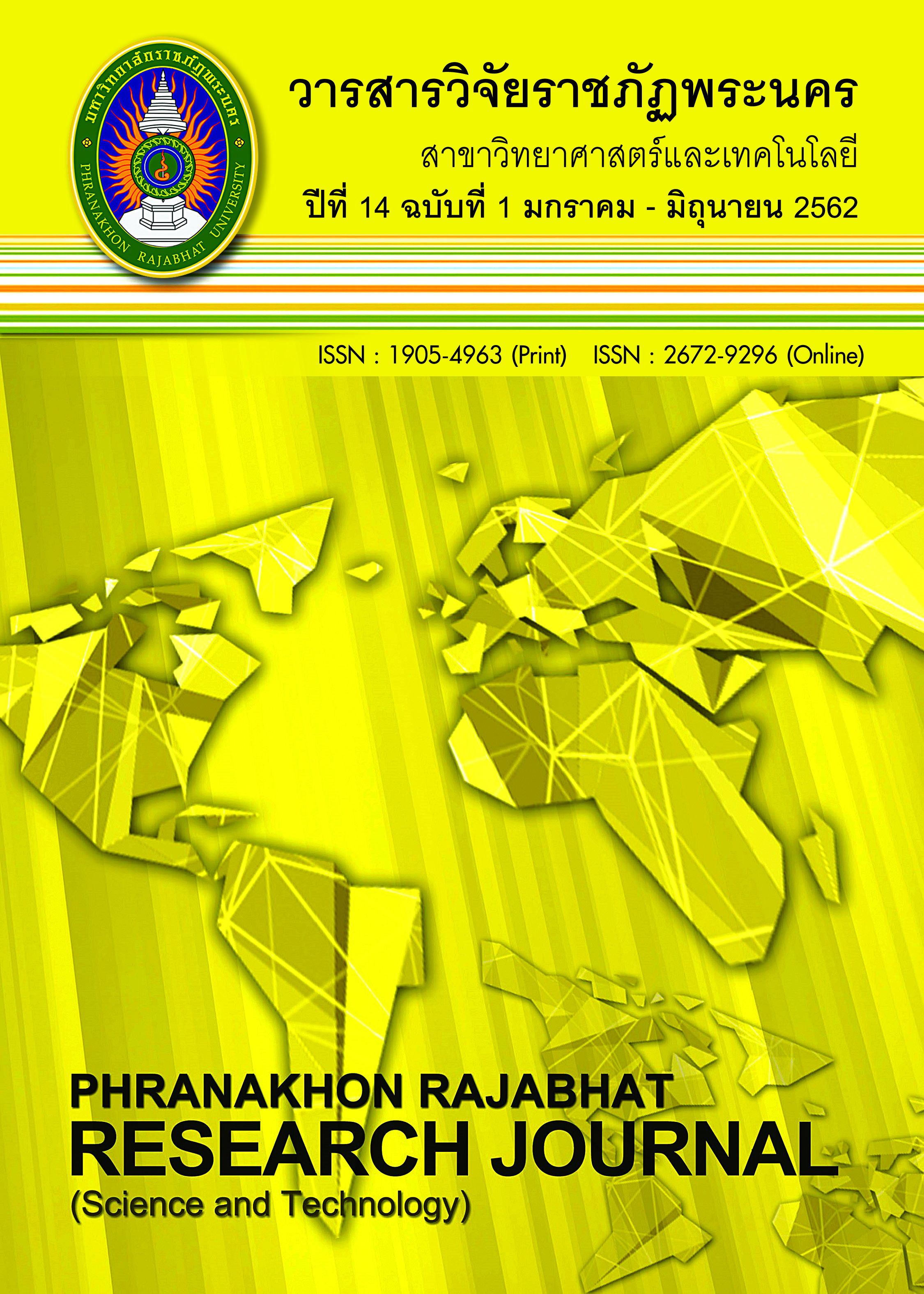THE PREPARATION OF WATER SOAKING WITH RICEBERRY RICE AND APPLICATION FOR COCONUT MILK JELLY
Keywords:
Riceberry rice, coconut milk jelly, antioxidantAbstract
The objective of this research was to study the optimum condition of Riceberry rice water extraction in coconut milk jelly. This study was selected with the 3 formulas of coconut milk jellies, which formula 1 of the coconut milk jelly had the highest scores of overall liking (p<0.05). The formula 1 of the coconut milk jelly was selected in the next step. After that, the Riceberry rice was extracted with water (2:1 w/w) by varying the extraction times (15 30 and 45 min). The results exhibited the coconut milk jelly using Riceberry rice water extract at 45 and 60 min were not significantly different (p>0.05). Therefore, the coconut milk jelly using Riceberry rice water extract at 45 min was chosen to determine the physico-chemical properties. The Lightness (L*) was decreased (p<0.05). On the other hand, the yellowness (b*) redness (a*) and gel strength trend to increase with an increasing of period time (p<0.05). Moreover, the total phenolic content and total anthocyanin content of the coconut milk jelly using Riceberry rice water extract at 45 min were 58.76 mgGAE/g and 5.87 mg/100g, respectively. The antioxidant activity (DPPH and ABTS) were measured with an IC50 values of 46.81 and 47.39 mg/mL, respectively.
References
Bainak, J., Wongpakdee, R. & Suksomboon, A. (2015) Development of Dried Rice Noodle (Kanom-geen) from Riceberry. Agricultural Science Journal. 46(3), 361-364. (in Thai)
Chaisuwan, S. (2012). Coconut milk jelly formula. Retrieved November 8, 2012, from https://www.baanpimwun.com. (in Thai)
Choi, Y., Lee, S.M., Chun, J., Lee H.B. & Lee, J. (2006). Influence of heat treatment on the antioxidant activities and polyphenolic compounds of shiitake (Lentinus edodes) mushroom. Food Chemistry. 99, 381-387.
Dai, B. & Matsukawa, S. (2012). NMR studies of the gelation mechanism and molecular dynamics in agar solutions. Food Hydrocolloids. 26, 181-186.
Finocchiaro, F., Ferrari, B. & Gianinetti, A. (2010). A study of biodiversity of flavonoid content in the rice caryopsis evidencing simultaneous accumulation ofanthocyanins and proanthocyanidins in a blackgrained genotype. Cereal
Science. 5, 28-34.
Hossain, S.J., Tsujiyama, I., Takasugi, M., Islam, M.A., Biswas, R.S. & Aoshima, H. (2008). Total phenolic content, antioxidative, anti-amylase, anti-glucosidase, and antihistamine release activities of Bangladeshi fruits. Food Science and Technology Research, 14(3), 261-268.
Ko, F.N., Cheng, Z.J., Lin, C.N. & Teng, C.M. (1998). Scavenger and antioxidant properties of prenylflavones isolated from Artocarpus heterophyllus. Free Radical Biology and Medicine. 25(2), 160-168
Leardkamolkarn, V., Thongthep, P., Suttiarporn, R., Kongkachuichai, S., Wongpornchai, S. & Wanavijitr, A. (2011). Chemopreventive properties of the bran extracted from a newly-developed Thai rice The Riceberry. Food Chemistry, 125, 978-85.
Oki, T., Masuda, V., Kobayash, V., Nishiba, V., Furuta, V., Suda, I. & Sato, T. (2002). Polymeric procyanidinsas radical-scavenging components in red-hulled rice. Journal of Agricultural and Food Chemistry, 50, 7524-7529.
Pattaneeya, P., Reuthaithip, S., Rin, C., Vijitra, L., Surat, K., Uruwan, Y., Apichart, V. & Ratchanee, K. (2013). Amelioration of hyperglycemia, hyperlipidimia, oxidative stress and inflammation in steptozotocin-induced diabetic rats
fed a high fat diet by riceberry supplement. Journal of Functional Foods. 5, 195-203.
Podjanalekha, P., Saenmuan, S., & Phothiset, S. (2018). Effect of temperatures on physicochemical properties of Riceberry flour. Khon Kaen Agriculture Journal, 46, 212-217. (in Thai)
Ramadhan, R. & Phuwapraisirisan, P. (2015). Arylalkanones from Horsfieldia macrobotrys are effective antidiabetic agents achieved by alpha-glucosidase inhibition and radical scavenging. Natural product communications. 10(2),
325-328.
Somboon, N. (2013). Properties of Agar and Fish Gelatin Mixed Gels. M.Sc. Program in Food Science and Nutrition. Faculty of Science and Technology, Prince of Songkhla University. (in Thai)
Tasiri, P., Suttisansanee, U., Hudthagosol, C. & Somboonpanyakul, P. (2015). Development of Riceberry Rice Vegan Jelly Contains High Protein and High Energy for the Elderly with Dysphagia. Agricultural Science Journal. 46(3),
369-372. (in Thai)
Downloads
Published
Issue
Section
License
โปรดกรอกเอกสารและลงนาม "หนังสือรับรองให้ตีพิมพ์บทความในวารสารวิจัยมหาวิทยาลัยราชภัฏพระนคร สาขาวิทยาศาสตร์และเทคโนโลยี" ก่อนการตีพิมพ์



